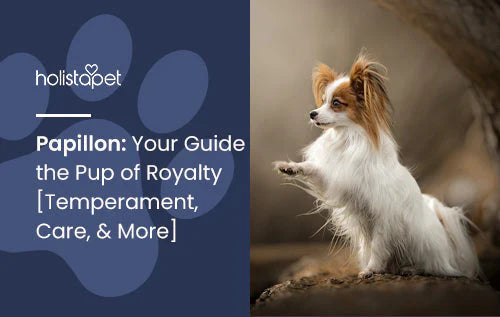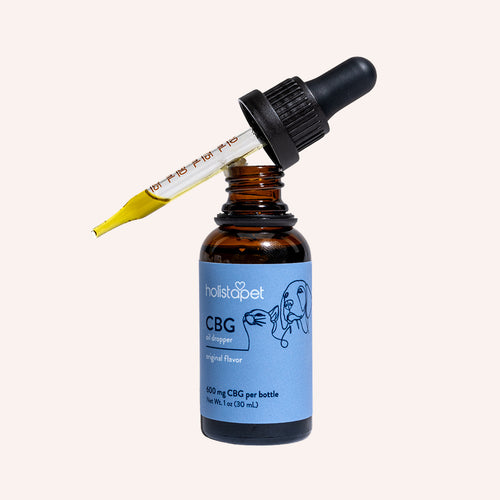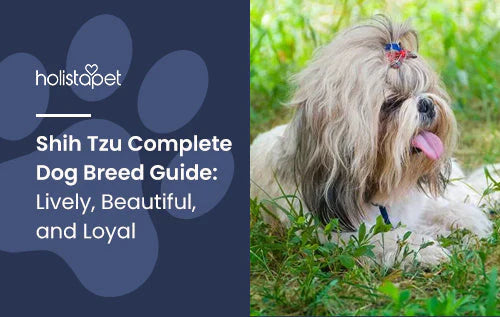The beautiful Papillon dog has been a treasured breed throughout history. From their popularity in royal courts to the attention they received from historical figures like King Louis XIV and Marie Antoinette, these little dogs are nothing short of glorious. This dazzling and regal breed remains one of the most popular canines in the world today, incredibly affectionate and loyal dogs that can be perfect for the right owner!

Papillon Breed Characteristics (Physical)
Papillons are often depicted in paintings from a few of history's most renowned artists like Rubens, Goya, and Rembrandt. Perhaps their most recognizable trait is their beautiful, butterfly-like ears, making them well-known as the "butterfly dog." Both ear types are accepted by the American Kennel Club (AKC) as part of the breed standard. The phalene variety more rare, but it is not uncommon to find both ear types of Papillon in the same litter.
The Papillon's large, erect ears have luxurious feathering. They have small, dark, round eyes that are constantly darting around, surveying their surroundings. Despite their slight, dainty build, Papillons have athletic bodies that help them excel at physical activities. They have well-developed shoulders and hind legs that allow them to jump high and run like the wind. Papillons have relatively long lifespans at around 12-16 years.
Papillon Breed Size
The Papillon is a small dog that puts them in the toy dog breed category. They stand 8-11 inches at the shoulder and weigh on average only about 5-10 pounds. Males can be slightly larger than females, but the difference is barely noticeable with their diminutive sizes. Any Papillons over 11 inches is considered to be faulty by breed standards.

Papillon Breed Personality
Papillons are highly independent dogs that are more content with running and playing than cuddling and watching TV. Their high energy level and constant need for stimulation can often put them in mischievous situations. You should begin training your Papillon as early as possible to limit destructive behaviors. Papillons also have a loyal and protective side that makes them excellent watchdogs if they sense danger.
Papillons also have an affectionate side that is constantly seeking your attention. Their need for physical and mental stimulation is matched by their desire to please. If Papillons are left alone for extended periods, they may develop separation anxiety. If you are gone for hours a day at work or often take business trips, Papillons may not be the best breed for you.
Papillon Breed Exercise
Papillons are an extremely active breed that requires moderate to intense levels of physical activity. Giving your Papillon regular exercise and stimulation will help tire them out and make it easier for you to care for them. The best way to manage their high energy levels is to create a consistent exercise routine. Plan walks in the mornings, after lunch, in the evenings, or at night to help burn off their energy throughout the day.

Papillon Breed Training
Like other tiny breeds, Papillons may have small dog syndrome. This causes them to see themselves as more significant than you, which leads to trouble training them. Obedience classes are the best way to remedy this issue. Positive-reinforcement is one of the most effective ways to train all dogs, regardless of breed. Most dogs respond well to rewards such as praises or treats.
CBD calming chews are an excellent training tool for Papillons because they can make your dog take their energy down a notch and make them more receptive to commands. Besides calming chews, there are many CBD products for dogs available. Plus, you can use the treats to reinforce good behavior.
Try to keep training sessions short and sweet to cater to your Papillon's short attention span. Always stay positive, and never get frustrated if the first couple of sessions are unsuccessful. It may take more than a few tries to get the basic commands down, but as long as you stay consistent, Papillons will be able to pick up their training with ease.
Exposure to new experiences and other dogs helps desensitize your Papillon to potential stressors like loud noises or strangers. Though socialization continues through your dog's entire lifetime, command training can begin as early as eight weeks old, around the time you can bring new puppies home from the breeder.

Papillon Breed History
The Papillon breed originated in France around the 13th century. One of the oldest toy spaniel breeds, they were initially called "dwarf spaniels" and "butterfly dog." These early toy spaniels are ancestors to today's English Toy Spaniels, Cavalier King Charles Spaniels, and the Papillon. Although the locals nicknamed the breed "Papillon" for the ears, the breed is sometimes called the Continental Toy Spaniel.
Beginning in the 16th century, Papillon dogs were bred to be royal lapdogs for noblewomen across Europe — a practice that continued for hundreds of years. Prized for their beautiful looks and miniature size, Papillons quickly became favorites of high royalty, including King Louis XIV, King Henry II, and Marie Antoinette. You can often find Papillons in paintings side-by-side with these well-known historical figures.
The first Papillons arrived in the United States in the late 19th century. Papillons quickly gained popularity as people flocked to own this beautiful and stunning breed. By 1915, the American Kennel Club (AKC) officially recognized the first Papillon. Not long after, the Papillon Club of America (PCA) formed in 1935 as the first official breed club.

Papillon Breed Health Problems
Papillons are generally very healthy, but like all breeds, they can still develop certain genetic conditions. Most health issues have been eliminated by responsible breeding, but some might slip through the cracks. Always double-check with the breeder to ensure that the dog has been screened for any health conditions.
Patellar Luxation
Patellar luxation causes the kneecap to slip out of place and dislocate. In most cases, it occurs when the ligament attaching the kneecap to the knee is not centered properly, causing abnormal shifts and eventual dislocation. Here are some signs your dog may have this condition:
- Skipping or awkward gait
- Lameness in one or both legs
- Excessive shaking or flailing in an attempt to pop the kneecap back into place
- Bow-legged appearance in hind legs
- Decrease in movement
Hypoglycemia
Hypoglycemia, or low blood sugar (glucose), is a serious issue in smaller pets and toy dog breeds. Active dogs are also prone to low blood sugar if they overexert themselves during physical activity. Some symptoms of hypoglycemia in dogs are:
- Loss of appetite
- Increased hunger
- Low energy, weakness, or loss of consciousness
- Inability to complete simple tasks
- Anxiety or restlessness
- Excessive tremors or shaking

Tracheal Collapse
Tracheal collapse occurs when the trachea, the airway that brings air from the nose or mouth to the lungs, collapses on itself and restricts breathing. This condition is most common in middle-aged or toy dog breeds. Some signs of a collapsed trachea include:
- Difficulty breathing
- Loud, honking coughs
- Vomiting, gagging immediately following a cough
- Excessive wheezing
Progressive Retinal Atrophy (PRA)
Progressive retinal atrophy is a degenerative eye disease that eventually leads to blindness in the dog. In early-onset PRA, the photoreceptor cells do not develop normally, causing permanent vision problems during growth. In late-onset PRA, the cells start to deteriorate over time after they have developed. PRA occurs most commonly in mixed breeds and found mainly in male dogs. You may notice certain signs that indicate impaired vision loss, such as:
- Night blindness or reluctance to go into dark rooms
- Bumping into objects or walls
- Glossy or reflective pupils
- Increased clumsiness

Open Fontanel
An open fontanel is a hole in a dog's head that results from an underdeveloped skull. This condition is more common in smaller breeds, and it can be quite dangerous as it leaves the brain exposed. Open fontanelles are often inherited. If you notice any soft spots or holes on your dog's head, take them to the vet immediately for diagnoses.
Related: What is the Healthiest Dog Breed? [Top 12 List]
How to Care for a Papillon Dog
Papillons are royalty and not suited for outdoor living, but their compact size makes them great apartment dogs. If your Papilion is going to be your flatmate, be prepared to give them plenty of physical activity opportunities. If they don't get enough exercise, they may run all over the house, potentially knocking things over. Teach them to dismount from high areas safely or provide steps to allow them to come down quickly.

Nutrition and Feeding for a Papillon Dog
We generally recommend feeding your adult Papillon about a quarter to half a cup of high-quality dog food per day. It's best to split their feedings into multiple meals so they don't eat too quickly. Eating too fast can cause bloat, which is dangerous for your dog. Monitor your dog closely to determine how much to feed them. Small dogs are especially prone to obesity, so be mindful of how much human food and snacks you feed your Papillon.
Papillon Colors And Grooming
Part of the Papillon's beauty is their long, flowing coat that is extremely soft to the touch. Their silky, coat flows in the wind with heavy feathering around the ears, backs of the legs, and chest. At the end of their body, the Papillon's fluffy tail stands proudly in the air. Papillons are particolored, meaning they are typically white with patches of other colors. These colors are most commonly:
- Black
- Brown (chocolate)
- Tan or sand
- Sable or fawn

How to Groom
Papillons only have a single layer of hair, so it is relatively easy to keep them well-groomed. Their coats do not usually get tangled or matted, but we still recommend brushing them weekly to keep the coat healthy and shiny. A great tool to use is a stainless steel pin brush with long fine teeth. You can also use a grooming spray to protect the coat. The spray will make the coat easier to brush and help remove any dirt.
Grooming Tips
Small dogs are usually more prone to gum disease, so try to brush your Papillon's teeth at least once or twice a week. Keep your Papillon's nails short, so they aren't snagging on furniture or scratching you when they jump in your lap. Daily exercise and activity should be enough to wear the nails down, but if you can hear them clicking on the floor, it's a sign they need trimming.
Children and Other Pets
Papillons are great for families, but their high energy levels may be too much for young children. Mishandling a Papillon can lead to injuries or cause them to defend themselves. Teach children proper manners for playing, such as never grabbing a dog by its tail or disturbing the dog while eating. Always supervise interactions between young children and your Papillon to ensure that neither party gets hurt.

Papillons are not aggressive animals and can get along great with other pets. If you have a cat at home, they may even become best friends since they're similar in size. Papillons may try to boss around larger dogs, but they are still very friendly and can fit into almost any household.
Rescue Groups
One of these fantastic rescue groups for this breed is the Papillon 911 Rescue & Adoption, Inc., based out of Marietta, GA. They are a national organization that rescues Papillons and Papillon mixes alike, providing necessary food, shelter, and medical care. The group's main mission is to rescue Papillons from breeding mills, and to date, they have saved 551 Papillons since 2010.

Breed Organizations
The official breed club in America for Papillons is the Papillon Club of America, Inc. The organization is recognized by the AKC as the parent breed club. The PCA is an excellent resource for all things Papillon-related. It is a membership club that offers a great chance to meet other Papillon enthusiasts and learn more about the breed. There is also a dedicated section on how to find reputable and responsible breeders.
More About This Dog Breed
Papillons are among the most popular breeds in America, but they are still relatively uncommon to find. It may cost over $300 to adopt from a shelter and about $1000-3000 to adopt from a breeder. Always get the medical history and any health condition screening tests from the breeder to ensure the Papillon you are adopting is fully healthy.
Final Thoughts
Papillons are wonderful dogs that have a lot of spunk and energy. They take a lot of patience to deal with, but taking the time and effort to train and raise them can make them one of the best family companions you could ever have. From royal lapdogs to your couch at home, Papillons are sure to add a bit of spice into your life!


 CBD Oil for Dogs - Fast Acting
CBD Oil for Dogs - Fast Acting
 Chicken Flavored CBD Oil For Dogs - Easy Dose
Chicken Flavored CBD Oil For Dogs - Easy Dose
 Salmon Flavored CBD Oil For Dogs - Highly Rated
Salmon Flavored CBD Oil For Dogs - Highly Rated
 CBG Oil for Dogs and Cats - Loved by Thousands
CBG Oil for Dogs and Cats - Loved by Thousands




Leave a comment
All comments are moderated before being published.
This site is protected by hCaptcha and the hCaptcha Privacy Policy and Terms of Service apply.